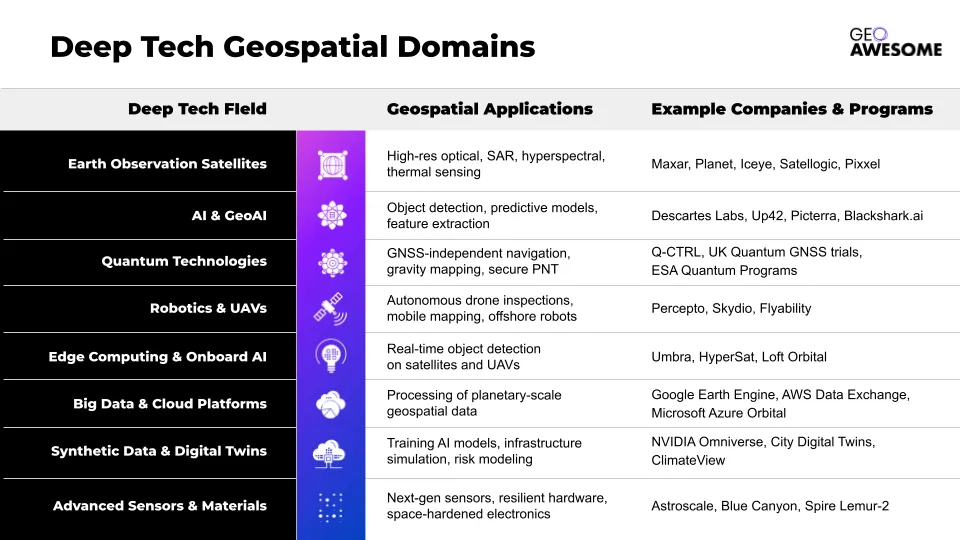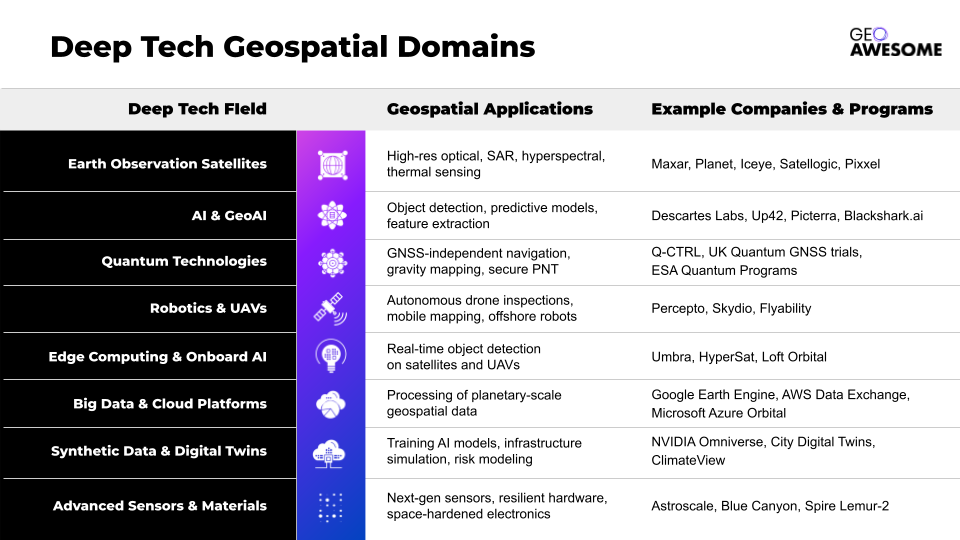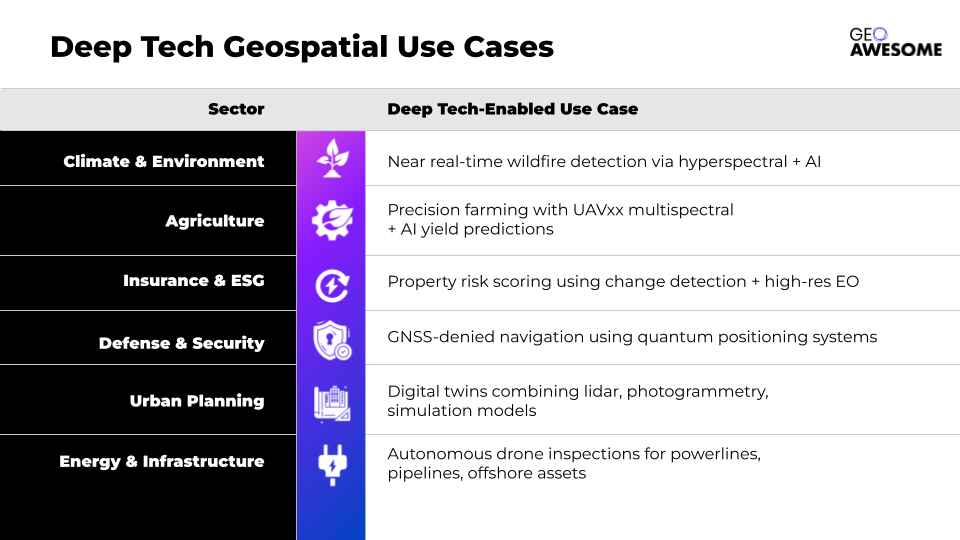
The Deep Tech Revolution in Geospatial: Where Science Meets Real-World Impact
For years, geospatial technology was synonymous with maps and satellite imagery. But beneath the surface, a much deeper transformation has been underway. Today, geospatial is no longer just a question of “where.” It’s about how we observe, analyze, and predict the world with a level of precision, speed, and scale that was previously unthinkable.
At the heart of this evolution is Deep Tech — a class of technology driven by advanced science, long-term research, and engineering breakthroughs that cross multiple disciplines. In sectors ranging from climate resilience to defense, geospatial Deep Tech is unlocking entirely new capabilities, opening fresh markets, and solving increasingly complex global challenges.
What Exactly Is Deep Tech — And Why Does It Matter for Geospatial?
Deep Tech sits at the intersection of science and application. These are not off-the-shelf software products or incremental app improvements. Instead, they involve years of scientific discovery, high-risk engineering, and often, the blending of hardware, algorithms, and massive data.

In geospatial, this means everything from next-generation Earth observation satellites to AI models that analyze real-time imagery, to quantum-based navigation systems that work even when GPS signals fail.
At its core, Deep Tech in geospatial changes not just what we can see, but how fast we can see it, how deeply we can analyze it, and how confidently we can act on it.
The Deep Tech Domains Fueling Geospatial Innovation
At the center of this transformation is a growing stack of scientific disciplines and technologies working together:

What’s remarkable here is that no single domain can deliver these breakthroughs alone. A hyperspectral satellite, for example, may generate highly detailed imagery. But its true commercial and operational value only emerges when combined with AI models that can process and classify that data in near real-time, cloud platforms capable of managing petabytes of information, and edge computing that can filter signals before transmission.
This is the defining characteristic of Deep Tech: its power lies in convergence — where multiple advanced technologies collaborate to create solutions that none could achieve in isolation.
Why Geospatial May Be the Most Natural Deep Tech Industry
While many sectors are experimenting with Deep Tech, geospatial may be one of the few industries that practically require it.
Consider the operational environment: satellite constellations capturing imagery around the clock, generating petabyte-scale datasets; autonomous drones navigating complex urban or industrial sites; government agencies monitoring forests, coastlines, or urban infrastructure in real time. The precision requirements are extreme — often demanding sub-meter or even centimeter-level accuracy — and the decisions based on this data frequently have life-or-death or multi-billion-dollar implications.
This unique intersection of hardware, algorithms, and mission-critical urgency means that geospatial companies are often solving some of the hardest technical challenges in the entire Deep Tech landscape. The result: when they succeed, they don’t just build better maps — they enable entirely new business models.
Deep Tech Use Cases Are Already Commercial
Perhaps the most telling sign of geospatial’s Deep Tech momentum is how quickly the commercial use cases are maturing:

These aren’t science experiments. From early wildfire detection to AI-powered crop forecasts and autonomous inspection drones, many of these solutions are already in operation today — deployed by insurers, governments, energy companies, and defense organizations worldwide.
What’s especially notable is how automation and prediction are emerging as the dominant themes. What once required teams of analysts and months of post-processing is increasingly becoming real-time, continuous, and scalable — allowing for operational decisions that are not just better informed, but faster and more resilient to change.
The Real Acceleration: Deep Tech Convergence
While individual technologies are advancing rapidly, the real acceleration in geospatial Deep Tech is happening at the points where multiple disciplines intersect:
- AI + EO + Edge Computing → Allowing real-time analytics directly from orbit or drones, dramatically reducing latency between observation and action.
- Quantum + GNSS + Sensor Fusion → Enabling navigation systems that remain accurate even in GPS-denied environments, a critical capability for defense and autonomous operations.
- Digital Twins + Climate Models + Predictive AI → Giving governments and insurers new tools to forecast urban risk, optimize infrastructure, and prepare for climate-driven events with far greater accuracy.
In this world, the companies best positioned to lead are not necessarily those who excel in one domain, but those capable of orchestrating multi-domain integrations into defensible, scalable solutions. The new competitive advantage is systems integration at the frontier of science.
The Takeaway: Geospatial Deep Tech Is Already Here
This is no longer a five-year vision — it’s already reshaping how we monitor the planet, manage infrastructure, respond to disasters, and forecast risk.
- The sensors are smaller, cheaper, and more advanced.
- The AI models are more powerful and better trained.
- The cloud infrastructure is finally built to scale.
- The scientific barriers that limited the sector for decades are rapidly falling.
Geospatial sits at the intersection of some of the most exciting frontiers in Deep Tech. As advances in sensors, AI, quantum, and autonomy accelerate, we’re entering an era where location intelligence is not just about “where” — but about “how fast,” “how deep,” and “how predictive.”
Do you like this article? Read more and subscribe to our monthly newsletter!





